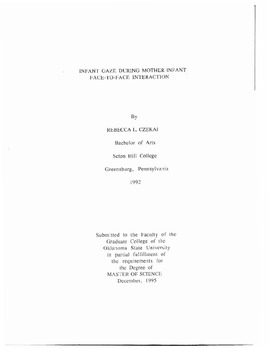| dc.description.abstract | Numerous research studies have examined mother-infant face-to-face interactions. A common goal of these studies has been to identify the characteristics of both the mother and the infant that affect social interaction. One area of theory and research has focused specifically on the communication patterns that develop in the mother-infant dyad; both the verbal and nonverbal aspects of this relationship have been investigated. Past research studies have also demonstrated that nearly one third of early parent-infant interactions can be considered play which is defined as social interactions that occur when the infant is alert and the caregiver's needs have been met (Stern, 1974; Field 1979). Based on this definition, play represents a unique set of social interactions that may vary among individuals and as a result contribute to individual differences in social development. Roggman and Peery (1989) suggest that patterns of parent-infant play may develop very early and are specific to the gender of both the infant and the parent. If this is true, then some gender differences which occur later in a child's development may begin in infancy during these early parent-infant interactions. As a result, gender-related variation in parent infant interaction may contribute to the beginning of differential socialization for males and females (Roggman & Peery, 1989). The main purpose of the current research was to improve understanding of early social interactions, specifically mother-infant play interactions during the first six months of life. Past research has suggested that gender affects infant completion of studies involving changes in a mother's pace of interaction, but has failed to examine the relationship of age in conjunction with gender (Burlie, 1992). In addition, infant gender has been shown to alter the gaze behaviors of mothers (Roggman & Peery, t989). Stem (1974) stated that gaze behavior is important in maternal satisfaction with play interactions. Therefore, the specific purpose of this research is to analyze infant gaze behaviors during mother-infant face-to-face interaction, looking specifically at the effects of infant gender, infant age, and change in maternal pacing on infant gaze behaviors. Infant gaze differs for boys and girls. In normal play situations, three- and four month- old girls gazed longer at their mothers than boys did (Fogel, Toda & Kawai, 1988; Roggman & Peery, 1989). This research indicates that females are more attentive during normal play than males. However, a study done by Tronick & Cohn (1989) found that sons are more likely than daughters to match behavior states with their mothers. They also reported that sons are more synchronized with their mothers than daughters at six and nine months. Although, the data also suggest that daughters are synchronized at three months (Tronick & Cohn, 1989). These results are supported by Burlie's 1992 study in which three-month-old females were unable to return to normal play behavior once the mother slowed down her play behavior and as a result broke the synchrony of the interaction. The present study investigated how gaze behaviors vary across gender, and how these differences vary with the age of the infant Research shows that the amount of time infants spend gazing at their mothers changes with age. Gaze behaviors usually increase from birth up until three or four months of age when the behavior begins to decrease. At six months the infant's focal environment increases to include objects which decreases the amount of time that the infant spends gazing at the mother (Cohn & Tronick, 1987; Stack & Muir, 1990). As a result, sixmonth- olds may not be as sensitive to changes in their mother's behavior. The present study will examine gaze behaviors in infants who are one to six months of age. Previous studies on infant gaze behaviors have not focused on the 1 to 2 month age range. As a result, this study will provide insight into some of the earliest gaze behaviors as well as the more complex gaze behaviors which develop along with the infant's visual-motor system. | |
